Input interpretation

H_2S (hydrogen sulfide) + CuSO_4 (copper(II) sulfate) ⟶ H_2SO_4 (sulfuric acid) + CuS (cupric sulfide)
Balanced equation
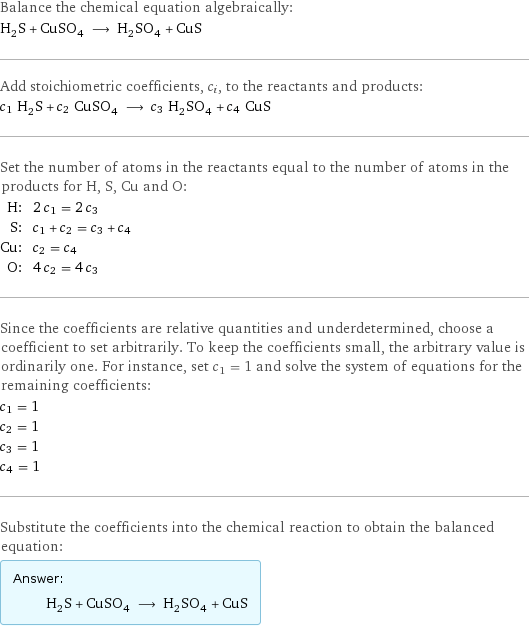
Balance the chemical equation algebraically: H_2S + CuSO_4 ⟶ H_2SO_4 + CuS Add stoichiometric coefficients, c_i, to the reactants and products: c_1 H_2S + c_2 CuSO_4 ⟶ c_3 H_2SO_4 + c_4 CuS Set the number of atoms in the reactants equal to the number of atoms in the products for H, S, Cu and O: H: | 2 c_1 = 2 c_3 S: | c_1 + c_2 = c_3 + c_4 Cu: | c_2 = c_4 O: | 4 c_2 = 4 c_3 Since the coefficients are relative quantities and underdetermined, choose a coefficient to set arbitrarily. To keep the coefficients small, the arbitrary value is ordinarily one. For instance, set c_1 = 1 and solve the system of equations for the remaining coefficients: c_1 = 1 c_2 = 1 c_3 = 1 c_4 = 1 Substitute the coefficients into the chemical reaction to obtain the balanced equation: Answer: | | H_2S + CuSO_4 ⟶ H_2SO_4 + CuS
Structures

+ ⟶ +
Names

hydrogen sulfide + copper(II) sulfate ⟶ sulfuric acid + cupric sulfide
Reaction thermodynamics
Enthalpy
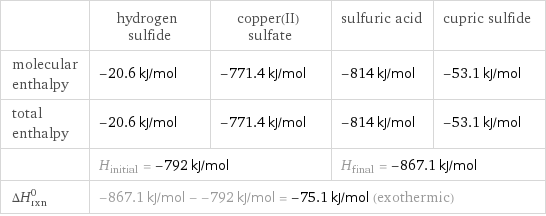
| hydrogen sulfide | copper(II) sulfate | sulfuric acid | cupric sulfide molecular enthalpy | -20.6 kJ/mol | -771.4 kJ/mol | -814 kJ/mol | -53.1 kJ/mol total enthalpy | -20.6 kJ/mol | -771.4 kJ/mol | -814 kJ/mol | -53.1 kJ/mol | H_initial = -792 kJ/mol | | H_final = -867.1 kJ/mol | ΔH_rxn^0 | -867.1 kJ/mol - -792 kJ/mol = -75.1 kJ/mol (exothermic) | | |
Gibbs free energy
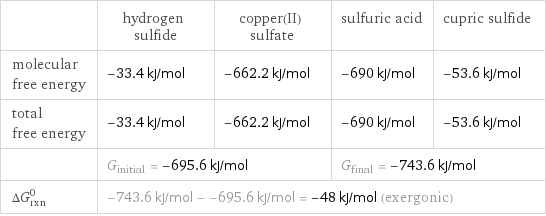
| hydrogen sulfide | copper(II) sulfate | sulfuric acid | cupric sulfide molecular free energy | -33.4 kJ/mol | -662.2 kJ/mol | -690 kJ/mol | -53.6 kJ/mol total free energy | -33.4 kJ/mol | -662.2 kJ/mol | -690 kJ/mol | -53.6 kJ/mol | G_initial = -695.6 kJ/mol | | G_final = -743.6 kJ/mol | ΔG_rxn^0 | -743.6 kJ/mol - -695.6 kJ/mol = -48 kJ/mol (exergonic) | | |
Equilibrium constant
![Construct the equilibrium constant, K, expression for: H_2S + CuSO_4 ⟶ H_2SO_4 + CuS Plan: • Balance the chemical equation. • Determine the stoichiometric numbers. • Assemble the activity expression for each chemical species. • Use the activity expressions to build the equilibrium constant expression. Write the balanced chemical equation: H_2S + CuSO_4 ⟶ H_2SO_4 + CuS Assign stoichiometric numbers, ν_i, using the stoichiometric coefficients, c_i, from the balanced chemical equation in the following manner: ν_i = -c_i for reactants and ν_i = c_i for products: chemical species | c_i | ν_i H_2S | 1 | -1 CuSO_4 | 1 | -1 H_2SO_4 | 1 | 1 CuS | 1 | 1 Assemble the activity expressions accounting for the state of matter and ν_i: chemical species | c_i | ν_i | activity expression H_2S | 1 | -1 | ([H2S])^(-1) CuSO_4 | 1 | -1 | ([CuSO4])^(-1) H_2SO_4 | 1 | 1 | [H2SO4] CuS | 1 | 1 | [CuS] The equilibrium constant symbol in the concentration basis is: K_c Mulitply the activity expressions to arrive at the K_c expression: Answer: | | K_c = ([H2S])^(-1) ([CuSO4])^(-1) [H2SO4] [CuS] = ([H2SO4] [CuS])/([H2S] [CuSO4])](../image_source/cf09b3580fb50bd026cc7b2c2a05a33a.png)
Construct the equilibrium constant, K, expression for: H_2S + CuSO_4 ⟶ H_2SO_4 + CuS Plan: • Balance the chemical equation. • Determine the stoichiometric numbers. • Assemble the activity expression for each chemical species. • Use the activity expressions to build the equilibrium constant expression. Write the balanced chemical equation: H_2S + CuSO_4 ⟶ H_2SO_4 + CuS Assign stoichiometric numbers, ν_i, using the stoichiometric coefficients, c_i, from the balanced chemical equation in the following manner: ν_i = -c_i for reactants and ν_i = c_i for products: chemical species | c_i | ν_i H_2S | 1 | -1 CuSO_4 | 1 | -1 H_2SO_4 | 1 | 1 CuS | 1 | 1 Assemble the activity expressions accounting for the state of matter and ν_i: chemical species | c_i | ν_i | activity expression H_2S | 1 | -1 | ([H2S])^(-1) CuSO_4 | 1 | -1 | ([CuSO4])^(-1) H_2SO_4 | 1 | 1 | [H2SO4] CuS | 1 | 1 | [CuS] The equilibrium constant symbol in the concentration basis is: K_c Mulitply the activity expressions to arrive at the K_c expression: Answer: | | K_c = ([H2S])^(-1) ([CuSO4])^(-1) [H2SO4] [CuS] = ([H2SO4] [CuS])/([H2S] [CuSO4])
Rate of reaction
![Construct the rate of reaction expression for: H_2S + CuSO_4 ⟶ H_2SO_4 + CuS Plan: • Balance the chemical equation. • Determine the stoichiometric numbers. • Assemble the rate term for each chemical species. • Write the rate of reaction expression. Write the balanced chemical equation: H_2S + CuSO_4 ⟶ H_2SO_4 + CuS Assign stoichiometric numbers, ν_i, using the stoichiometric coefficients, c_i, from the balanced chemical equation in the following manner: ν_i = -c_i for reactants and ν_i = c_i for products: chemical species | c_i | ν_i H_2S | 1 | -1 CuSO_4 | 1 | -1 H_2SO_4 | 1 | 1 CuS | 1 | 1 The rate term for each chemical species, B_i, is 1/ν_i(Δ[B_i])/(Δt) where [B_i] is the amount concentration and t is time: chemical species | c_i | ν_i | rate term H_2S | 1 | -1 | -(Δ[H2S])/(Δt) CuSO_4 | 1 | -1 | -(Δ[CuSO4])/(Δt) H_2SO_4 | 1 | 1 | (Δ[H2SO4])/(Δt) CuS | 1 | 1 | (Δ[CuS])/(Δt) (for infinitesimal rate of change, replace Δ with d) Set the rate terms equal to each other to arrive at the rate expression: Answer: | | rate = -(Δ[H2S])/(Δt) = -(Δ[CuSO4])/(Δt) = (Δ[H2SO4])/(Δt) = (Δ[CuS])/(Δt) (assuming constant volume and no accumulation of intermediates or side products)](../image_source/2fee207ad6b8aaa775b195a08b67bbdb.png)
Construct the rate of reaction expression for: H_2S + CuSO_4 ⟶ H_2SO_4 + CuS Plan: • Balance the chemical equation. • Determine the stoichiometric numbers. • Assemble the rate term for each chemical species. • Write the rate of reaction expression. Write the balanced chemical equation: H_2S + CuSO_4 ⟶ H_2SO_4 + CuS Assign stoichiometric numbers, ν_i, using the stoichiometric coefficients, c_i, from the balanced chemical equation in the following manner: ν_i = -c_i for reactants and ν_i = c_i for products: chemical species | c_i | ν_i H_2S | 1 | -1 CuSO_4 | 1 | -1 H_2SO_4 | 1 | 1 CuS | 1 | 1 The rate term for each chemical species, B_i, is 1/ν_i(Δ[B_i])/(Δt) where [B_i] is the amount concentration and t is time: chemical species | c_i | ν_i | rate term H_2S | 1 | -1 | -(Δ[H2S])/(Δt) CuSO_4 | 1 | -1 | -(Δ[CuSO4])/(Δt) H_2SO_4 | 1 | 1 | (Δ[H2SO4])/(Δt) CuS | 1 | 1 | (Δ[CuS])/(Δt) (for infinitesimal rate of change, replace Δ with d) Set the rate terms equal to each other to arrive at the rate expression: Answer: | | rate = -(Δ[H2S])/(Δt) = -(Δ[CuSO4])/(Δt) = (Δ[H2SO4])/(Δt) = (Δ[CuS])/(Δt) (assuming constant volume and no accumulation of intermediates or side products)
Chemical names and formulas
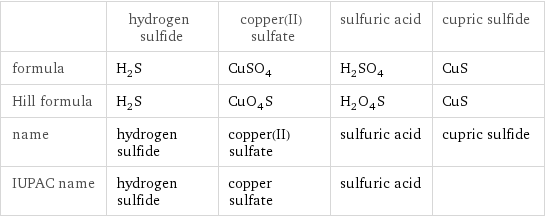
| hydrogen sulfide | copper(II) sulfate | sulfuric acid | cupric sulfide formula | H_2S | CuSO_4 | H_2SO_4 | CuS Hill formula | H_2S | CuO_4S | H_2O_4S | CuS name | hydrogen sulfide | copper(II) sulfate | sulfuric acid | cupric sulfide IUPAC name | hydrogen sulfide | copper sulfate | sulfuric acid |
Substance properties
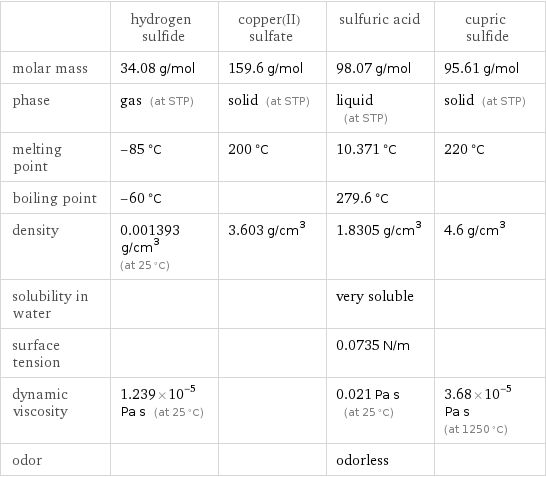
| hydrogen sulfide | copper(II) sulfate | sulfuric acid | cupric sulfide molar mass | 34.08 g/mol | 159.6 g/mol | 98.07 g/mol | 95.61 g/mol phase | gas (at STP) | solid (at STP) | liquid (at STP) | solid (at STP) melting point | -85 °C | 200 °C | 10.371 °C | 220 °C boiling point | -60 °C | | 279.6 °C | density | 0.001393 g/cm^3 (at 25 °C) | 3.603 g/cm^3 | 1.8305 g/cm^3 | 4.6 g/cm^3 solubility in water | | | very soluble | surface tension | | | 0.0735 N/m | dynamic viscosity | 1.239×10^-5 Pa s (at 25 °C) | | 0.021 Pa s (at 25 °C) | 3.68×10^-5 Pa s (at 1250 °C) odor | | | odorless |
Units
